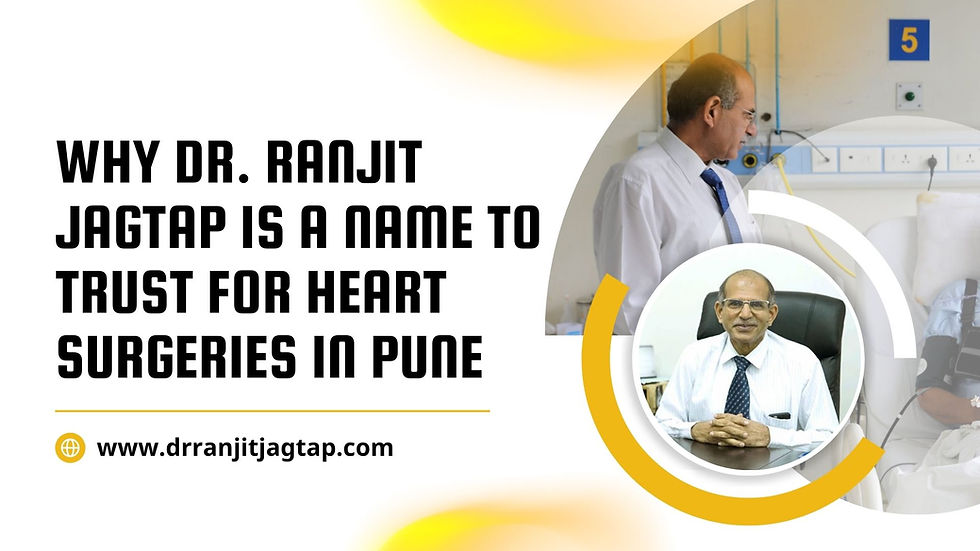Dr Ranjit Jagtap : Keeping Your Mitral Valve Healthy As You Age
- drranjitjagdap
- Mar 14, 2024
- 3 min read

As blood floats through the pumping organ, there are four valves to keep blood drifting in the right direction. What this means is, the mitral valve is placed on the left side of your heart, regulating blood to flow in the middle of the left atrium and left ventricle.
Dr Ranjit Jagtap, a cardiac surgeon and founder of a cardiac specialist hospital is also known as heart specialist hospital which carries the highest success rate of cardiac surgeries. Ram Mangal Heart Foundation, started in 2014, with 4079+ cardiac surgeries completed so far. Here, the best medical professional delivers the finest quality of heart care treatment at an affordable price range with utmost ethics, experience, excellence and quality care staff. If you are experiencing heart disease , getting in touch with highly experienced cardiac surgeon like Dr Ranjit Jagtap would be a great decision
Proper Functioning Of Mitral Valves:
Further, specialists at Dr Ranjit Jagtap Clinic, explains, Looking over the functioning of mitral valve. Pulmonary veins feed oxygen rich blood flow to the left atrium. Once, left atrium is filled , the mitral valve opens and allows blood to flow in the left ventricle. Immediately after which, the mitral valve closes so that blood doesn’t flow back to the left atrium. It is always a well-designed process that happens in a matter of a few seconds.
According to Dr Ranjit Jagtap News, the Mitral valve has two leaflets. Think of it as a double door. They are the part of the Mitral valve that opens and closes with a spring pressure , allowing blood to pass and consecutively, blocking it from flowing backward. There is a fan-shaped, well connectable fiber, in the walls of valves which ensures opening and closing of the Mitral Valve with less tension.
With Mitral Valve, certain things can go wrong:
Certainly, birth defects, aging, and other medical conditions, are the reasons by which problems with heart valves may occur. In blood, heart valves accumulate, fare deposits of calcium and minerals. As a sign of relief, this impacts the mitral valve much. Patients who are suffering with bicuspid aortic valve, calcium deposit thickens the leaflets of aortic valve and makes it narrow.
Similarly, degenerative valve disease affects the mitral valve more frequently than others . Mitral valve prolapse is another example of degenerative valve disease ,which makes the leaflets and chordae tendineae more stretchy causing the leaflets to bow and in extreme cases to leak blood . Majority of people with this condition have no leak or very mild leak, for which annual monitoring is enough .
The Mitral valve is likely to leak or mitral valve regurgitation . Over time they may stretch or damage the leaflets , elongating the fibers that support them. Eventually, it can become worse that the leaflets may not close as they should be.
Prominent Ways To Reduce Risk of Heart Valve Problems
Dr Ranjit Jagtap Daughter, Aditi Jagtap Pune, contributes in taking good care of the patients recovering from a heart disease. While there is less to no guarantee that you’re ever going to witness heart valve problems, several lifestyle choices can be managed to reduce overall risk.
Results, Not Promises:
If you are experiencing heart valve problems, it would be amazing to aim for at least two and a half hours of modern intensity workout on a moderate to vigorous level. How do you think exercise could be more efficient? Exercising on a regular basis, can help you lower bad LDL cholesterol and improve good HDL cholesterol level, with a good control of high blood pressure — all risk factors for heart disease.
Maintaining a healthy weight :
People who are overweight have a higher chance of developing coronary heart disease, high blood pressure, breathing problems, type 2 diabetes and more.
Quit Smoking:
Excessive smoking can reduce your entire risk of heart disease or heart attack etc. Try to avoid reckless smoking.





Comments